Analysis of Joint Actions and Muscle Involvement in Vertical Jumping
VerifiedAdded on 2019/11/26
|6
|977
|302
Report
AI Summary
This report provides a biomechanical analysis of the preparatory phase of jumping, examining the movements of the ankle, knee, hip, and body trunk. It details the joint actions, including plantar flexion, extension, and hyperextension, and identifies the active muscles involved, such as the dorsiflexors, vastus lateralis, rectus femoris, and iliopsoas. The report discusses the role of pronation and muscle contractions in facilitating the jump, and how the body trunk contributes to stability. The analysis covers the initial and final stages of the preparatory phase, illustrating the muscle actions and joint movements that enable a vertical jump. The report concludes with a bibliography of relevant sources.

Biomechanics 1
BIOMECHANICS
By Name
Course
Instructor
Institution
Location
Date
BIOMECHANICS
By Name
Course
Instructor
Institution
Location
Date
Paraphrase This Document
Need a fresh take? Get an instant paraphrase of this document with our AI Paraphraser
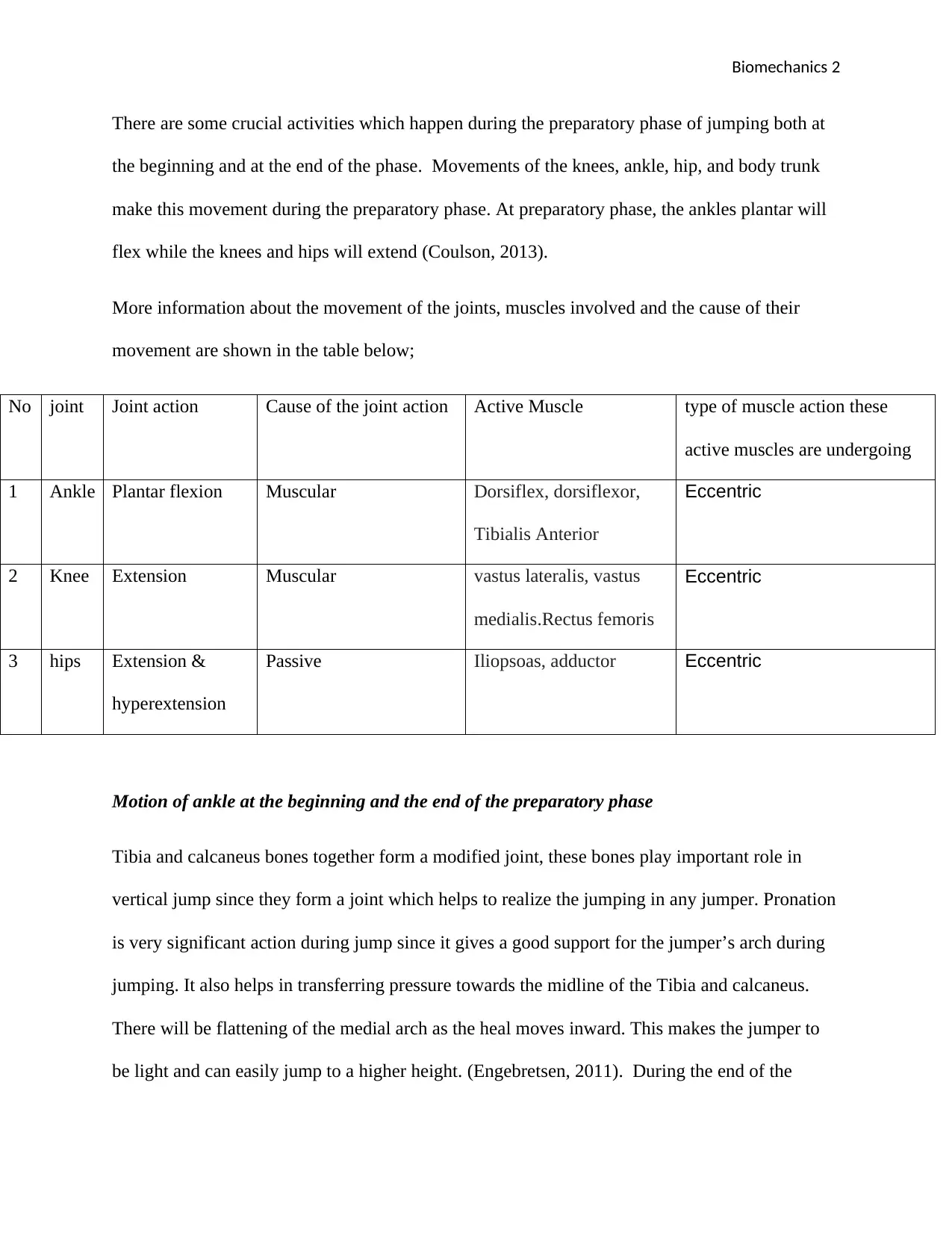
Biomechanics 2
There are some crucial activities which happen during the preparatory phase of jumping both at
the beginning and at the end of the phase. Movements of the knees, ankle, hip, and body trunk
make this movement during the preparatory phase. At preparatory phase, the ankles plantar will
flex while the knees and hips will extend (Coulson, 2013).
More information about the movement of the joints, muscles involved and the cause of their
movement are shown in the table below;
No joint Joint action Cause of the joint action Active Muscle type of muscle action these
active muscles are undergoing
1 Ankle Plantar flexion Muscular Dorsiflex, dorsiflexor,
Tibialis Anterior
Eccentric
2 Knee Extension Muscular vastus lateralis, vastus
medialis.Rectus femoris
Eccentric
3 hips Extension &
hyperextension
Passive Iliopsoas, adductor Eccentric
Motion of ankle at the beginning and the end of the preparatory phase
Tibia and calcaneus bones together form a modified joint, these bones play important role in
vertical jump since they form a joint which helps to realize the jumping in any jumper. Pronation
is very significant action during jump since it gives a good support for the jumper’s arch during
jumping. It also helps in transferring pressure towards the midline of the Tibia and calcaneus.
There will be flattening of the medial arch as the heal moves inward. This makes the jumper to
be light and can easily jump to a higher height. (Engebretsen, 2011). During the end of the
There are some crucial activities which happen during the preparatory phase of jumping both at
the beginning and at the end of the phase. Movements of the knees, ankle, hip, and body trunk
make this movement during the preparatory phase. At preparatory phase, the ankles plantar will
flex while the knees and hips will extend (Coulson, 2013).
More information about the movement of the joints, muscles involved and the cause of their
movement are shown in the table below;
No joint Joint action Cause of the joint action Active Muscle type of muscle action these
active muscles are undergoing
1 Ankle Plantar flexion Muscular Dorsiflex, dorsiflexor,
Tibialis Anterior
Eccentric
2 Knee Extension Muscular vastus lateralis, vastus
medialis.Rectus femoris
Eccentric
3 hips Extension &
hyperextension
Passive Iliopsoas, adductor Eccentric
Motion of ankle at the beginning and the end of the preparatory phase
Tibia and calcaneus bones together form a modified joint, these bones play important role in
vertical jump since they form a joint which helps to realize the jumping in any jumper. Pronation
is very significant action during jump since it gives a good support for the jumper’s arch during
jumping. It also helps in transferring pressure towards the midline of the Tibia and calcaneus.
There will be flattening of the medial arch as the heal moves inward. This makes the jumper to
be light and can easily jump to a higher height. (Engebretsen, 2011). During the end of the
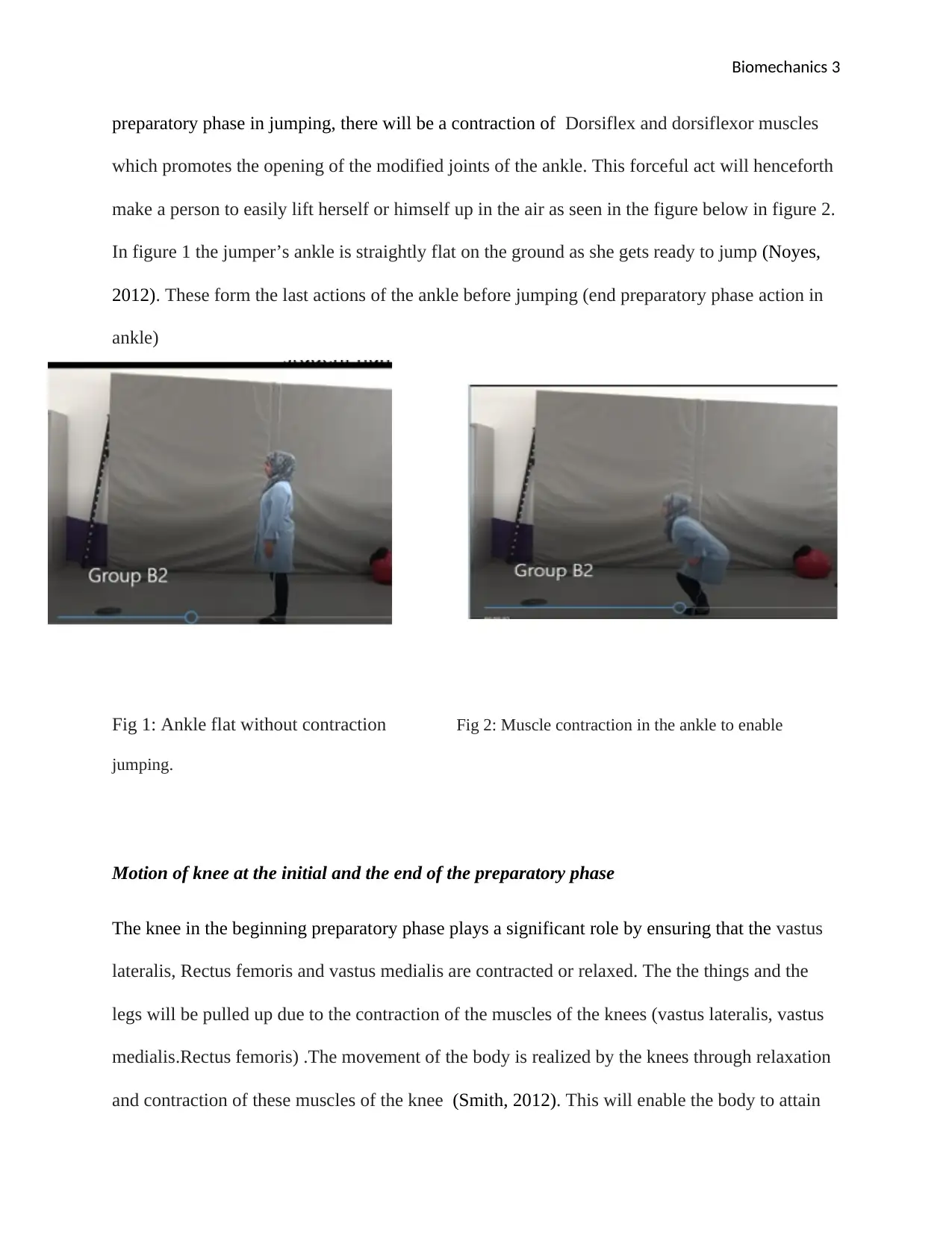
Biomechanics 3
preparatory phase in jumping, there will be a contraction of Dorsiflex and dorsiflexor muscles
which promotes the opening of the modified joints of the ankle. This forceful act will henceforth
make a person to easily lift herself or himself up in the air as seen in the figure below in figure 2.
In figure 1 the jumper’s ankle is straightly flat on the ground as she gets ready to jump (Noyes,
2012). These form the last actions of the ankle before jumping (end preparatory phase action in
ankle)
Fig 1: Ankle flat without contraction Fig 2: Muscle contraction in the ankle to enable
jumping.
Motion of knee at the initial and the end of the preparatory phase
The knee in the beginning preparatory phase plays a significant role by ensuring that the vastus
lateralis, Rectus femoris and vastus medialis are contracted or relaxed. The the things and the
legs will be pulled up due to the contraction of the muscles of the knees (vastus lateralis, vastus
medialis.Rectus femoris) .The movement of the body is realized by the knees through relaxation
and contraction of these muscles of the knee (Smith, 2012). This will enable the body to attain
preparatory phase in jumping, there will be a contraction of Dorsiflex and dorsiflexor muscles
which promotes the opening of the modified joints of the ankle. This forceful act will henceforth
make a person to easily lift herself or himself up in the air as seen in the figure below in figure 2.
In figure 1 the jumper’s ankle is straightly flat on the ground as she gets ready to jump (Noyes,
2012). These form the last actions of the ankle before jumping (end preparatory phase action in
ankle)
Fig 1: Ankle flat without contraction Fig 2: Muscle contraction in the ankle to enable
jumping.
Motion of knee at the initial and the end of the preparatory phase
The knee in the beginning preparatory phase plays a significant role by ensuring that the vastus
lateralis, Rectus femoris and vastus medialis are contracted or relaxed. The the things and the
legs will be pulled up due to the contraction of the muscles of the knees (vastus lateralis, vastus
medialis.Rectus femoris) .The movement of the body is realized by the knees through relaxation
and contraction of these muscles of the knee (Smith, 2012). This will enable the body to attain
⊘ This is a preview!⊘
Do you want full access?
Subscribe today to unlock all pages.

Trusted by 1+ million students worldwide
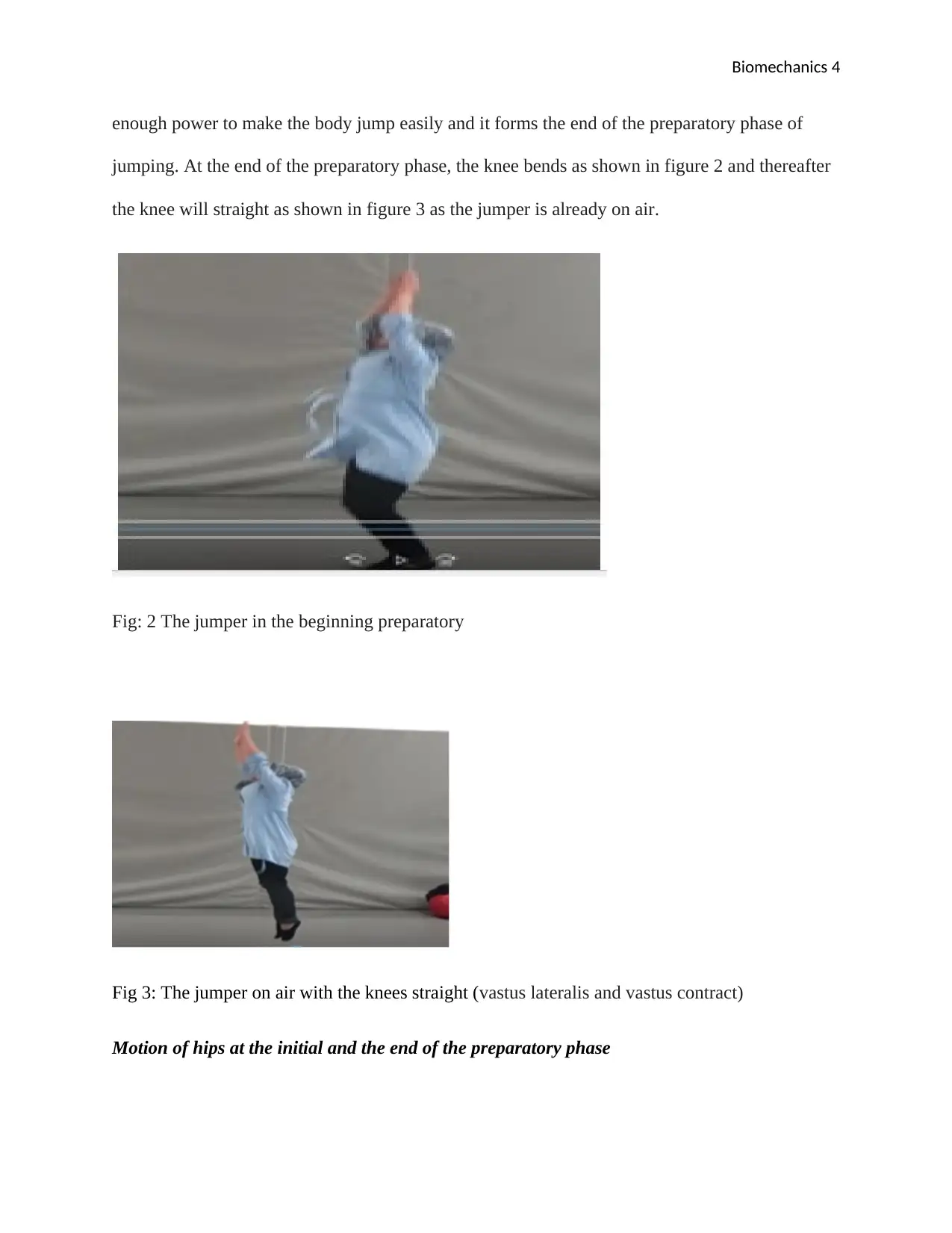
Biomechanics 4
enough power to make the body jump easily and it forms the end of the preparatory phase of
jumping. At the end of the preparatory phase, the knee bends as shown in figure 2 and thereafter
the knee will straight as shown in figure 3 as the jumper is already on air.
Fig: 2 The jumper in the beginning preparatory
Fig 3: The jumper on air with the knees straight (vastus lateralis and vastus contract)
Motion of hips at the initial and the end of the preparatory phase
enough power to make the body jump easily and it forms the end of the preparatory phase of
jumping. At the end of the preparatory phase, the knee bends as shown in figure 2 and thereafter
the knee will straight as shown in figure 3 as the jumper is already on air.
Fig: 2 The jumper in the beginning preparatory
Fig 3: The jumper on air with the knees straight (vastus lateralis and vastus contract)
Motion of hips at the initial and the end of the preparatory phase
Paraphrase This Document
Need a fresh take? Get an instant paraphrase of this document with our AI Paraphraser
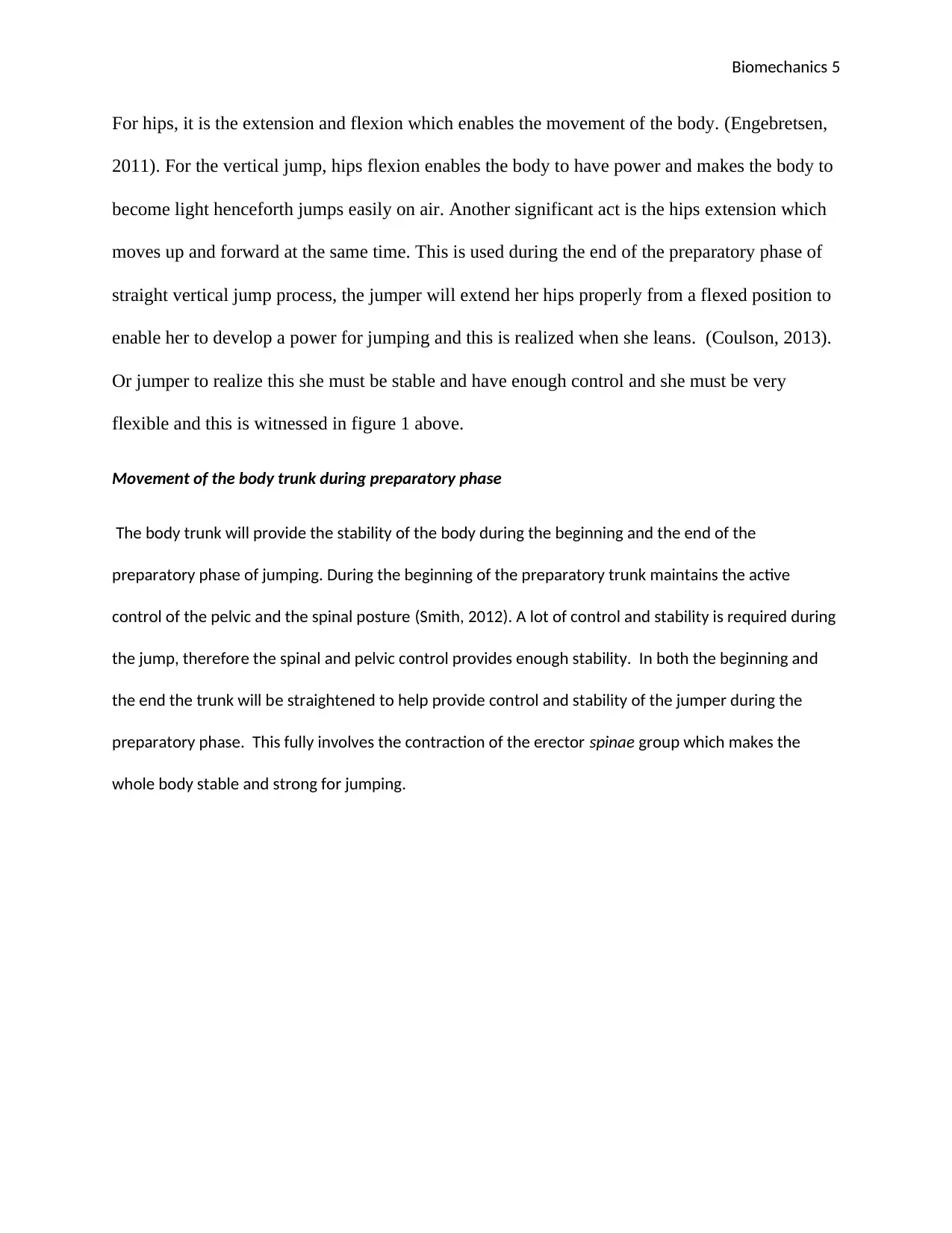
Biomechanics 5
For hips, it is the extension and flexion which enables the movement of the body. (Engebretsen,
2011). For the vertical jump, hips flexion enables the body to have power and makes the body to
become light henceforth jumps easily on air. Another significant act is the hips extension which
moves up and forward at the same time. This is used during the end of the preparatory phase of
straight vertical jump process, the jumper will extend her hips properly from a flexed position to
enable her to develop a power for jumping and this is realized when she leans. (Coulson, 2013).
Or jumper to realize this she must be stable and have enough control and she must be very
flexible and this is witnessed in figure 1 above.
Movement of the body trunk during preparatory phase
The body trunk will provide the stability of the body during the beginning and the end of the
preparatory phase of jumping. During the beginning of the preparatory trunk maintains the active
control of the pelvic and the spinal posture (Smith, 2012). A lot of control and stability is required during
the jump, therefore the spinal and pelvic control provides enough stability. In both the beginning and
the end the trunk will be straightened to help provide control and stability of the jumper during the
preparatory phase. This fully involves the contraction of the erector spinae group which makes the
whole body stable and strong for jumping.
For hips, it is the extension and flexion which enables the movement of the body. (Engebretsen,
2011). For the vertical jump, hips flexion enables the body to have power and makes the body to
become light henceforth jumps easily on air. Another significant act is the hips extension which
moves up and forward at the same time. This is used during the end of the preparatory phase of
straight vertical jump process, the jumper will extend her hips properly from a flexed position to
enable her to develop a power for jumping and this is realized when she leans. (Coulson, 2013).
Or jumper to realize this she must be stable and have enough control and she must be very
flexible and this is witnessed in figure 1 above.
Movement of the body trunk during preparatory phase
The body trunk will provide the stability of the body during the beginning and the end of the
preparatory phase of jumping. During the beginning of the preparatory trunk maintains the active
control of the pelvic and the spinal posture (Smith, 2012). A lot of control and stability is required during
the jump, therefore the spinal and pelvic control provides enough stability. In both the beginning and
the end the trunk will be straightened to help provide control and stability of the jumper during the
preparatory phase. This fully involves the contraction of the erector spinae group which makes the
whole body stable and strong for jumping.
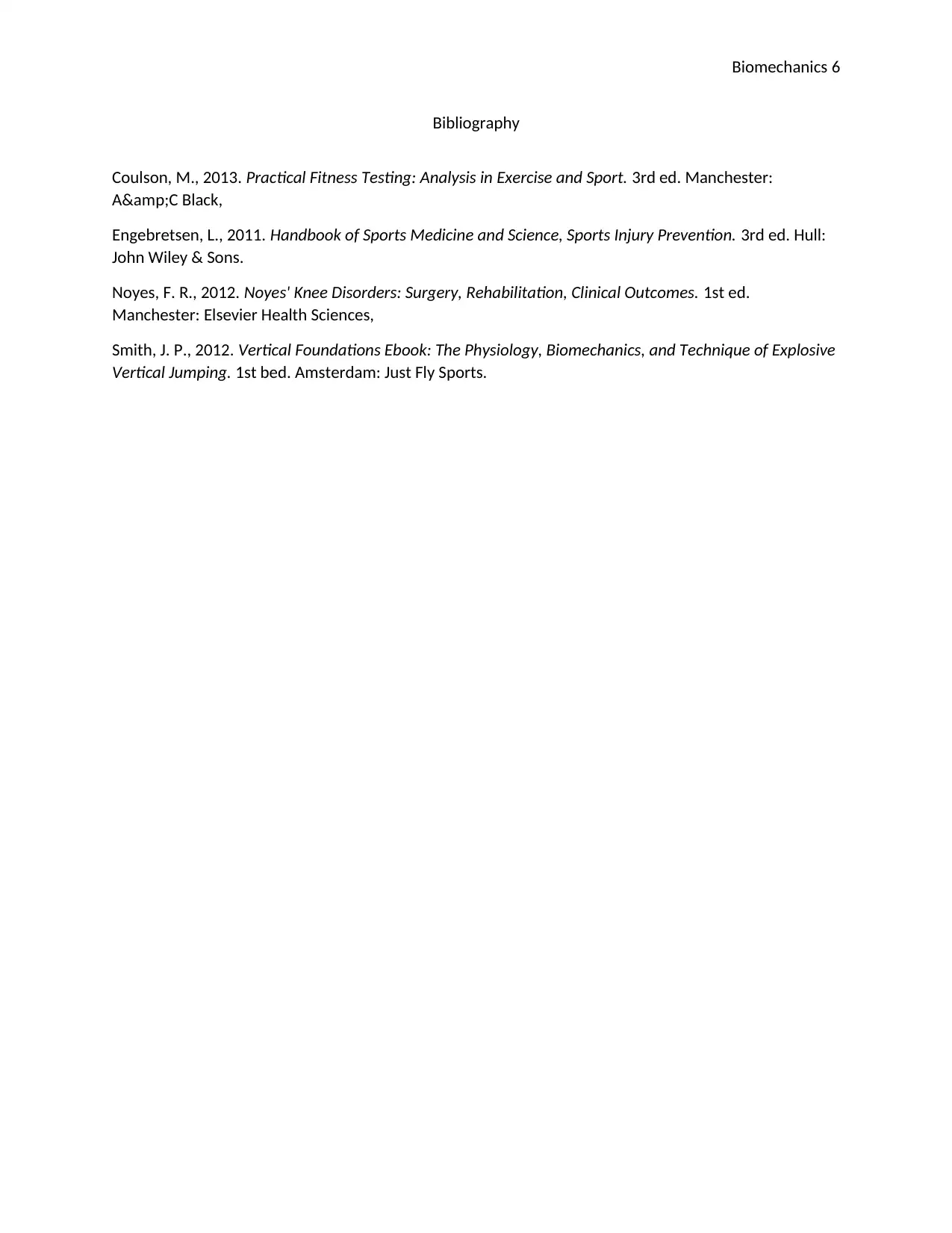
Biomechanics 6
Bibliography
Coulson, M., 2013. Practical Fitness Testing: Analysis in Exercise and Sport. 3rd ed. Manchester:
A&C Black,
Engebretsen, L., 2011. Handbook of Sports Medicine and Science, Sports Injury Prevention. 3rd ed. Hull:
John Wiley & Sons.
Noyes, F. R., 2012. Noyes' Knee Disorders: Surgery, Rehabilitation, Clinical Outcomes. 1st ed.
Manchester: Elsevier Health Sciences,
Smith, J. P., 2012. Vertical Foundations Ebook: The Physiology, Biomechanics, and Technique of Explosive
Vertical Jumping. 1st bed. Amsterdam: Just Fly Sports.
Bibliography
Coulson, M., 2013. Practical Fitness Testing: Analysis in Exercise and Sport. 3rd ed. Manchester:
A&C Black,
Engebretsen, L., 2011. Handbook of Sports Medicine and Science, Sports Injury Prevention. 3rd ed. Hull:
John Wiley & Sons.
Noyes, F. R., 2012. Noyes' Knee Disorders: Surgery, Rehabilitation, Clinical Outcomes. 1st ed.
Manchester: Elsevier Health Sciences,
Smith, J. P., 2012. Vertical Foundations Ebook: The Physiology, Biomechanics, and Technique of Explosive
Vertical Jumping. 1st bed. Amsterdam: Just Fly Sports.
⊘ This is a preview!⊘
Do you want full access?
Subscribe today to unlock all pages.

Trusted by 1+ million students worldwide
1 out of 6
Your All-in-One AI-Powered Toolkit for Academic Success.
+13062052269
info@desklib.com
Available 24*7 on WhatsApp / Email
![[object Object]](/_next/static/media/star-bottom.7253800d.svg)
Unlock your academic potential
Copyright © 2020–2025 A2Z Services. All Rights Reserved. Developed and managed by ZUCOL.

